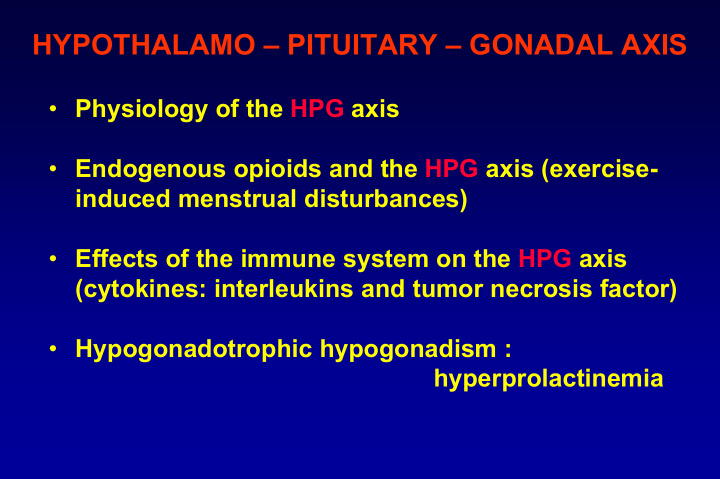



HYPOTHALAMO – PITUITARY – GONADAL AXIS • Physiology of the HPG axis • Endogenous opioids and the HPG axis (exercise- induced menstrual disturbances) • Effects of the immune system on the HPG axis (cytokines: interleukins and tumor necrosis factor) • Hypogonadotrophic hypogonadism : hyperprolactinemia
HYPOTHALAMUS LHRH : decapeptide (pattern of administration crucial for pituitary response : pulsatile vs continuous administration) PITUITARY LH, FSH : glycoproteins composed of 2 chains : α , β α chains are identical β chains are specific for each hormone β chains are biological active
HYPOTHALAMUS LHRH : decapeptide (pattern of administration crucial for pituitary response : pulsatile vs continuous administration) PITUITARY LH, FSH : glycoproteins composed of 2 chains : α , β α chains are identical β chains are specific for each hormone β chains are biological active
GONADS Sex steroids Estrogens Progestins Androgens Gonadal protein hormones inhibins - activins + modulating FSH Follistatins -
ENDOGENOUS OPIOIDS AND MENSTRUAL CYCLE DISTURBANCES
CONCLUSIONS • Exercise training frequently induces anovulatory menstrual cycles due to an increase in endogenous opioids • Exercise-induced amenorrhoea increases the risk of long-term osteoporosis, and may reflect overtraining • A decrease in percentage body fat inhibits GnRH through LEPTIN
ENDOGENOUS OPIOIDS DURING PREGNANCY
CYTOKINES : Polypeptides produced by cells from the immune system (macrophages, monocytes, lymphocytes) interleukins Tumor necrosis factor α Interferon • Cytokines are not only produced within the immune cells but also within : – Brain (astrocytes, glial cells, neurones (?) – Hypothalamus – Pituitary gland – Adrenal gland – Gonads – Thyroid gland
PATHOLOGIES OF THE PITUITARY AND HYPOGONADISM
PITUITARY ADENOMAS - Prolactinomas (PRL) ~ 50 % - Growth hormone (Acromegaly) ~ 20 % - ACTH (Cushing) ~ 10 % - TSH, LH-FSH, Alpha-subunit rare - Non functional tumors ~ 15-20 %
PITUITARY ADENOMAS • Endocrine effects : hyperfunction hypofunction both combined • Mass effect : compression of surrounding structures (neurological, pituitary)
SYMPTOMS OF MASS EFFECTS - Headache - Visual field defects : - superior temporal quadranopsia - bitemporal hemianopsia - Ophtalmology : lateral extension of adenomas into the cavernous sinus compromising function of III, IV and VI cranial nerve diplopia - Rinorrhea - Pituitary insufficiency
PROLACTINOMA The most frequent pituitary adenoma : ~ 50 % : microadenoma (<10 mm) : 50 % : macroadenoma (>10 mm) : more frequent
CLINICAL FEATURES IN WOMEN The classical manifestations of PRL excess : - amenorrhea and galactorrhea The gonadal dysfunction can produce any menstrual cycle dysfunction (amenorrhea, oligomenorrhea with anovulation, infertility) Estrogen deficiency may result in - decreased vaginal lubrification - decreased libido - osteopenia
CLINICAL FEATURES IN MEN Galactorrhea is significantly less frequent than in women Hypogonadism is responsible : - decreased libido - impotence - infertility - loss of axillary, facial, chest and pubic hair - slight testicular atrophy - gynecomasty
DOES HYPERPROLACTINEMIA ALWAYS MEAN THE PRESENCE OF A PROLACTINOMA?
CAUSES OF HYPERPROLACTINAEMIA (I) • Physiological • Pharmacological • Pathological • Idiopathic • Other causes
CAUSES OF HYPERPROLACTINAEMIA (II) Physiological Pregnancy Nursing Nipple stimulation Stress (physical, psychological, hypoglycemia) Exercice Food intake Sleep
CONDITIONS FOR BLOOD SAMPLING IN CASE OF SUSPECTED HYPERPROLACTINAEMIA Blood sampling : - in a fasting state - between 8h and 12h - take 2 - 3 blood samples at 30 min intervals (stress)
CAUSES OF HYPERPROLACTINAEMIA (III) Pharmacological Numerous drugs stimule PRL Antihypertensive drugs : - reserpine, a-methyldopa, verapamil Neuroleptics & antidepressants : - phenothiazines, butyrophenones, IMAO, benzamide, imipramine...
CAUSES OF HYPERPROLACTINAEMIA (IV) Pharmacological Antiemetics : metoclopramide, domperidone Hormones : estrogens (high dosage), TRH Opiates Anti-histaminic : cimetidine Anti-tbc : isoniazide
CAUSES OF HYPERPROLACTINAEMIA (V) Pathological • Prolactinomas • Mixed pituitary adenomas : GH + PRL • Defective hypothalamic dopamine secretion or transport to the lactotroph : - Hypothalamic tumors - Pituitary tumors (pseudoprolactinoma) - Trauma (stalk section) - Radiotherapy sequellae
CAUSES OF HYPERPROLACTINAEMIA (VI) • Stimulation of the lactotroph : - hypothyroidism (TRH) • Other causes : - renal failure - liver cirrhosis - diseases of the chest wall - PCOS • Macroprolactinaemia (Big - Big PRL)
INVESTIGATIONS OF HYPERPROLACTINAEMIA When a hyperprolactinaemia is suspected, before further and expensive investigations are proposed, it is necessary to - Obtain a careful history of drug intake - Eliminate a primary hypothyroidism - Control kidney and liver functions - In women with recent onset of amenorrhea or galactorrhea : pregnancy test
DIAGNOSIS OF HYPERPROLACTINAEMIA Basal PRL levels • Values >400 ng/ml are virtually diagnostic of prolactinoma • Values between 100 and 300 ng/ml are usually caused by a prolactinoma which is radiological evident • If PRL values < 100 ng/ml : can be difficult ! • There is generally a good correlation between PRL levels and the size of the adenoma
TRH TEST FOR PRL • 200 µ g TRH i.v. • Normal response : increase of PRL by > 100 % • Prolactinoma : no increase, or less than 30 % (macro) and less than 51 % (micro) • But does not exclude all forms of functional hyperprolactinaemia
INVESTIGATIONS OF PROLACTINOMAS • Basal PRL levels • TRH stimulation test on PRL (if doubts) • In case of macroadenoma : test other anterior pituitary functions • Imaging • Visual field
Recommend
More recommend